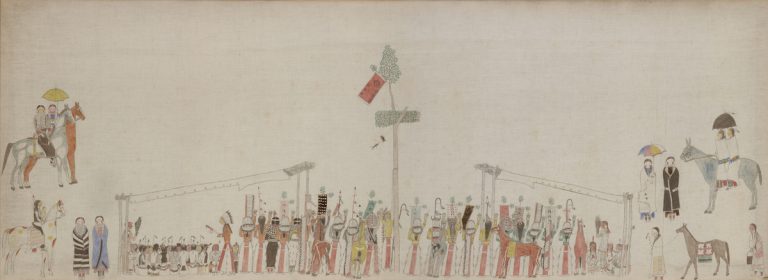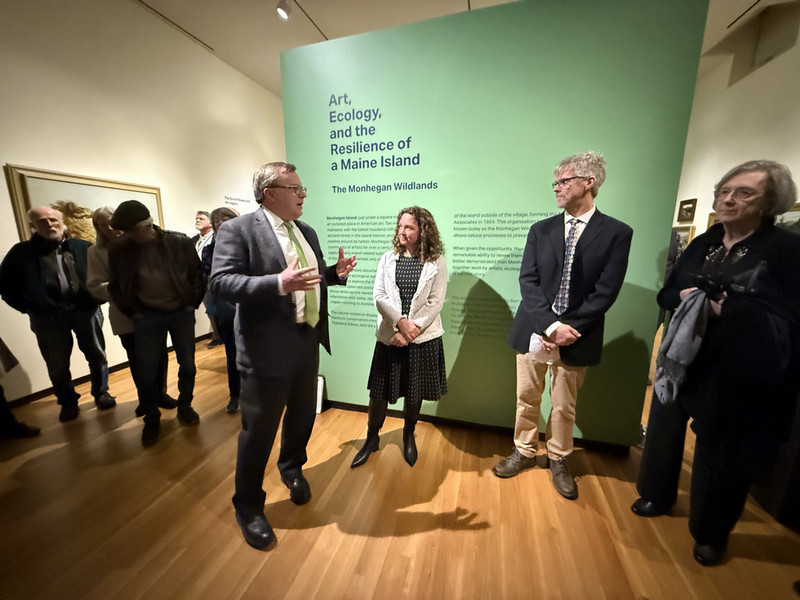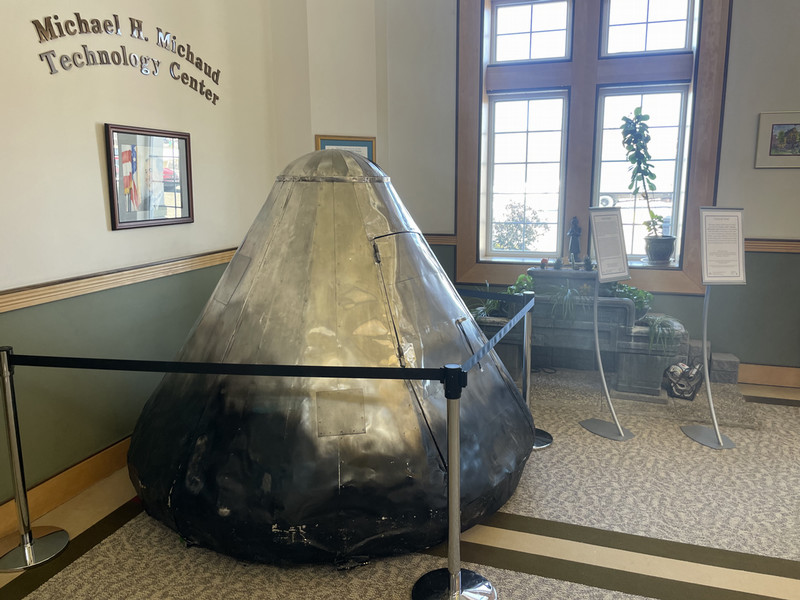New Lakota Painting at Art Museum Opens Window into American History
By Rebecca Goldfine
The Bowdoin Museum of Art has recently acquired a striking new work of art — a large Lakota muslin, painted by an unknown artist around 1895. The piece depicts a sun dance, an important religious ceremony that for centuries was observed by many Native Americans of the Great Plains. The dance was performed each summer as a rite of renewal for the community, but was banned by the US government in 1883. The law was not lifted until the 1970s.
The muslin painting, both through the scene it depicts and the story of its provenance, tells a story not only of the history and visual culture of the Lakota people, but also of the US’s inhumane treatment of indigenous people and — despite our government’s actions — the resilience of Native cultures today.
It was this historical and cultural significance, as well as its rarity and beauty, that led the Museum to seek out the piece. Each time the Museum makes a major acquisition, it gives careful consideration to an artwork that can illuminate, in a unique way, an important historical moment or artistic endeavor.
So when Museum Co-director Frank Goodyear learned that Sun Dance Ceremony was available from a private collector, he seized the chance last fall to bring it to Bowdoin. While the College’s art museum already has a strong collection of American art, the museum team is seeking to augment it with more Native art.
“As Bowdoin faculty are thinking about how to teach the history of artistic expression in the United States, we recognized that the contributions of Native artists were really important in telling a fuller story of American art,” Goodyear explained. He added, “Especially here in Maine, where there is a great tradition of Native American art in the state, we wanted to bring that history forward.”
“I think the artist is not necessarily interested in telling a story of a specific individual. The artist is much more interested in the larger group and the importance of the ceremony itself.”
—Museum of Art Co-director Frank Goodyear
While very little is known at the moment about who painted the muslin, art historians are able to decipher some of the clues in the piece to tell a story about who may have created the piece and why.
Indigenous communities in the West originally painted historical scenes on buffalo hides, and later on canvas or muslin, to line their teepees or log cabins. These accorded with the centuries-old custom of Native men making drawings and paintings to record significant historical events and individual feats.
By the end of the 19th century, Native artists were also increasingly selling their artworks to outsiders. “We believe, although it has not yet been confirmed, that [Sun Dance Ceremony] was either bought by or even commissioned by an Episcopal priest who was doing missionary work in the Dakotas at this particular time,” Goodyear said. “I find it interesting that a missionary would be so interested in the sun dance, a religious form of expression that had been outlawed by the US government only a decade or so previously.”
Janet Berlo, a professor of art history at the University of Rochester, and one of the most distinguished scholars of historic and contemporary Native American art, spoke at Bowdoin on Jan. 25 about Northern Plains Indian art from 1850 to the present. “In the beginning of the 20th century, men were making money by making art about these historical events,” Berlo said. “Men continued to paint scenes of the sun dance well into the early 20th century, and many were made for sale to outsiders to commemorate so-called lost traditions.”
But these traditions weren’t lost, she continued. The sun dance and other Native ceremonies were practiced surreptitiously, so that today, many details of old customs are still adhered to by Native people.
Among the many accurate details in Sun Dance Ceremony is the central tall pole, which was typically felled from a cottonwood tree in a sacred manner and then erected in the center of a dance circle. Twenty standing figures in a circle wear war paraphernalia, and their horses are painted for battle. “Because to take part in the sun dance takes great courage, the same kind of courage you need to go to war,” Berlo said.
The characters in the painting all contain individual touches, in their headdresses, clothing, or objects they are holding, such as umbrellas that shield some spectators from the bright sun. The details often reveal examples of the intricate patterns created by Lakota women for clothes and other textiles.
“Each character has a little thing that differentiates him or herself from the other person,” Goodyear said. “I think the artist is not necessarily interested in telling a story of a specific individual. The artist is much more interested in the larger group and the importance of the ceremony itself.”
Sun Dance Ceremony is in a current show at the Bowdoin College Museum of Art, Art from the Northern Plains, on view through July 8. Below is a slideshow of some of the work in the exhibition.






